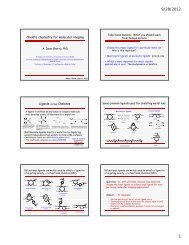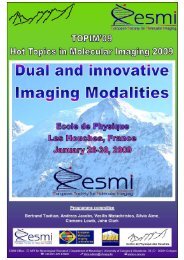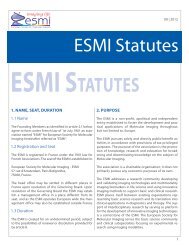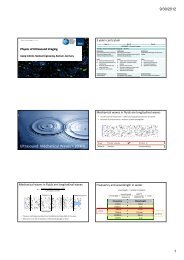5th EuropEan MolEcular IMagIng MEEtIng - ESMI
5th EuropEan MolEcular IMagIng MEEtIng - ESMI
5th EuropEan MolEcular IMagIng MEEtIng - ESMI
Create successful ePaper yourself
Turn your PDF publications into a flip-book with our unique Google optimized e-Paper software.
<strong>5th</strong> <strong>EuropEan</strong> <strong>MolEcular</strong> <strong>IMagIng</strong> <strong>MEEtIng</strong> – EMIM2010<br />
A system for 4D (3D+Kinetics) molecular imaging in bioluminescence and fluorescence<br />
Maitrejean S. (1) , Kyrgyzov I. (1) , Bonzom S. (1) , Levrey O. (1) , Le Masne Q. (1) , Hernandez L. (1) , Raphael B. (2) .<br />
(1) Biospace Lab,<br />
(2) CEA/DSV/ I2BM / SHFJ / LIME.<br />
smaitrejean@biospacelab.com<br />
Introduction: Several technologies and systems are<br />
now capable of delivering tri-dimensional data in Bioluminescence<br />
and Fluorescence imaging. However, all<br />
are based on sequential acquisitions, and therefore any<br />
of them allow the production of real kinetic data in<br />
3D. In this work we demonstrate a new device which<br />
is able to acquire Bioluminescence and Fluorescence<br />
data from several views simultaneously, allowing the<br />
reconstruction of tri-dimensional images while keeping<br />
all kinetic properties of the acquisition.<br />
Methods: Multiple views of Bioluminescence and Fluorescence<br />
data are acquired simultaneously using a photon<br />
counting device (Photon ImagerTM) in which a<br />
specific add-on with four mirrors is installed. This device<br />
(named 4Views) allows the concurrent acquisition<br />
of the ventral, dorsal, right, and left views of the animal<br />
in a single image. The size and intensity of the four subimages<br />
(i.e. the four views) are corrected by taking the<br />
true optical path into account. The corrected photon<br />
counting data are recorded in a list mode file with time<br />
information (43 frame/s) as can be seen in Fig1.<br />
In a second step a micro video projector is used to<br />
project a moving spot on the animal. For each position<br />
of the spot, the<br />
height of the animal<br />
is calculated<br />
by triangulation<br />
and a map of the<br />
surface of the animal<br />
is produced.<br />
As the chosen<br />
reconstruction<br />
Fig1: simultaneous acquisition of four views<br />
in bioluminescence imaging.<br />
method is based<br />
on the finite elements<br />
method,<br />
the volume of the animal is represented by a tetrahedral<br />
mesh (about 30 000 tetrahedrons) using the Delaunay<br />
algorithm, while the surface is approximated<br />
by triangles, using a marching cube method. Then, the<br />
forward problem is solved for given light sources that<br />
are placed at the nodes of tetrahedrons and the light<br />
intensities on the surface of the triangles are computed.<br />
The forward problem is based in this first version on a<br />
diffusion model with average constant absorption and<br />
diffusion parameters. In a next version, a registration of<br />
the surface of the animal with an anatomical atlas will<br />
allow to use optical parameters associated with each<br />
organ. In the following step measured data is extracted<br />
from the list mode file and mapped on the triangulated<br />
surface. Since the detected events are stored separately,<br />
any time interval from 22 ms (one frame) up to the<br />
total scan duration can be used to create the data. In<br />
the last step of the process, the inner light sources are<br />
estimated as the result of the inverse problem using a<br />
least square criterion with a Tikhonoff regularization<br />
term. This regularisation term is chosen as an entropic<br />
term in order to favour connected solution. The two<br />
last steps can be performed using any time interval of<br />
the list mode file and therefore 3D kinetic data can be<br />
computed for times scales larger than 22 ms.<br />
Results: The validity of the method has been first tested<br />
using light beads (Microtek) inside a half cylinder of a<br />
scattering material (delrin). It has been demonstrated<br />
that two light beads as close as three millimetres could<br />
be separated, at a depth of one centimetre. A second<br />
set of tests has been realised on an animal (nude mice)<br />
by placing the light beads in the rectum of the animal.<br />
On the second image (Fig 2) , two beads 9 mm far from<br />
each other were placed in the rectum. It was possible to<br />
reconstruct the two positions of the light sources. The<br />
distance between the two reconstructed sources is 9.77<br />
mm in good agreement.<br />
Fig2: Reconstruction of two light sources based<br />
on the four views data of fig1.<br />
Conclusions: 3D optical reconstruction is known to<br />
be approximate, but can give useful and satisfactory<br />
results in a large number of applications. We have<br />
demonstrated that this four view approach is able to<br />
provide 3D kinetic molecular imaging data with a<br />
spatial accuracy similar to other methods.<br />
Acknowledgement: This work was supported in part<br />
by the DIMI and ENCITE networks.<br />
<strong>EuropEan</strong> SocIEty for <strong>MolEcular</strong> <strong>IMagIng</strong> – <strong>ESMI</strong><br />
day1<br />
Parallel Session 3: TECHNOLOGY












